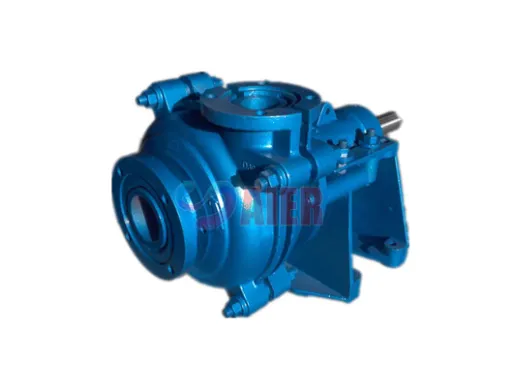Nov . 29, 2024 14:29 Back to list
Horizontal Froth Slurry Pump Manufacturing Insights and Best Practices for Efficient Production
Understanding Horizontal Froth Slurry Pumps An Overview
Horizontal froth slurry pumps are integral to several industries, particularly in the mining, mineral processing, and chemical sectors. These specialized pumps are designed to handle challenging materials such as slurries composed of solid particles suspended in liquid, which often include frothy substances presenting unique challenges to traditional pumping solutions. In this article, we will delve into the significance, functionality, and manufacturing processes of these pumps, as well as the advantages and factors to consider when selecting a pump for specific applications.
Significance of Horizontal Froth Slurry Pumps
Froth slurries can arise in various industrial processes, particularly in the extraction of minerals like gold, copper, and coal. The presence of air or gas bubbles in these slurries complicates the transportation process through conventional pumps, leading to inefficiencies and performance issues. Horizontal froth slurry pumps are specifically engineered to handle these frothy mixtures, enabling manufacturers to maintain operational efficiency and reduce downtime.
These pumps are known for their robust construction, which facilitates the handling of abrasive and corrosive materials. Their design ensures that pumps can withstand extreme conditions often present in mining and mineral processing environments, including high pressures and temperatures. This reliability is crucial for ensuring continuity in operations and optimizing production processes.
Functionality of Horizontal Froth Slurry Pumps
The fundamental working principle of a horizontal froth slurry pump involves the use of a rotating impeller within a volute casing. The impeller generates kinetic energy, which increases the velocity of the slurry. As the slurry enters the volute, the velocity is converted into pressure, enabling the slurry to be transported over long distances and through complex piping systems.
One of the critical features of horizontal froth slurry pumps is their ability to handle large volumes of air or gas mixed within the slurry. These pumps are designed to prevent the formation of vapor locks, which can severely impair functionality. They often incorporate various design elements, such as wider inlets, impeller designs with specialized profiles, and unique casing geometries, to manage frothy slurries efficiently.
Manufacturing Process
The manufacturing of horizontal froth slurry pumps involves several critical steps to ensure performance and durability. High-quality materials, often resistant to wear and corrosion, are selected to build the pump components. The manufacturing process includes casting or machining the pump casings and impellers to tolerance specifications that meet industry standards.
horizontal froth slurry pump factories

Advanced technologies such as computer-aided design (CAD) and computational fluid dynamics (CFD) simulations help in designing efficient pump models that can handle specific slurry characteristics. Rigorous testing follows the manufacturing process, where pumps undergo performance evaluations under various operating conditions to ensure reliability in real-world scenarios.
Advantages of Horizontal Froth Slurry Pumps
1. Efficiency These pumps are designed to transport frothy slurries effectively, minimizing energy consumption and enhancing productivity. 2. Durability Constructed from high-quality materials, horizontal froth slurry pumps exhibit excellent wear resistance, which extends their operational lifetimes.
3. Flexibility They can be configured to handle different types of slurries, allowing for use across various industries and applications.
4. Ease of Maintenance Many designs incorporate features that allow for straightforward maintenance, reducing downtime and associated costs.
Factors to Consider When Selecting a Pump
When selecting a horizontal froth slurry pump, several factors must be considered
- Type of Slurry Understanding the composition and behavior of the slurry is vital for selecting an appropriate pump model. - Flow Rate and Head Requirements These parameters influence the pump's sizing and selection, ensuring it meets the operational needs efficiently. - Material Compatibility The pump's materials must be compatible with the slurry to prevent degradation and failure. - Environmental Factors Considerations for temperature, pressure, and the overall operating environment are essential for ensuring the longevity and performance of the pump.
In conclusion, horizontal froth slurry pumps are pivotal in industries dealing with challenging slurry materials. Understanding their functionality, manufacturing process, and advantages can significantly aid companies in making informed decisions that boost operational efficiencies and drive productivity. With the right pump, businesses can effectively manage frothy slurries, ensuring streamlined processes and optimal performance.
-
High Quality Slurry Pump Seals Reliable China Suppliers & Manufacturers
NewsJun.24,2025
-
High Quality Portable Submersible Slurry Pump Supplier & Manufacturer from China
NewsJun.10,2025
-
Slurry Pump Parts Manufacturer – High Quality Rubber Spare Parts from China
NewsJun.10,2025
-
High Quality 1/3 HP Submersible Sump Pump with Vertical - Reliable Supplier & Factory Price
NewsJun.10,2025
-
High-Efficiency Centrifugal Slurry Pumps India
NewsJun.10,2025
-
High Quality Warman Centrifugal Slurry Pump Suppliers & Factory
NewsJun.10,2025
